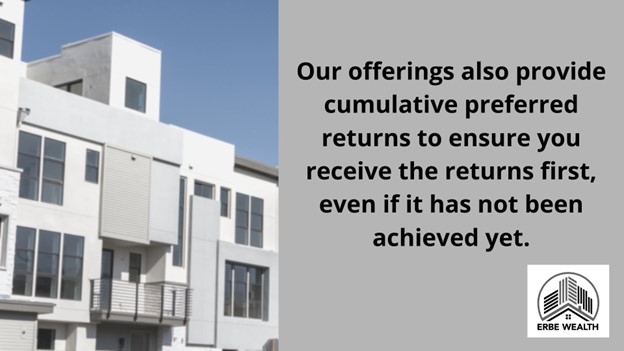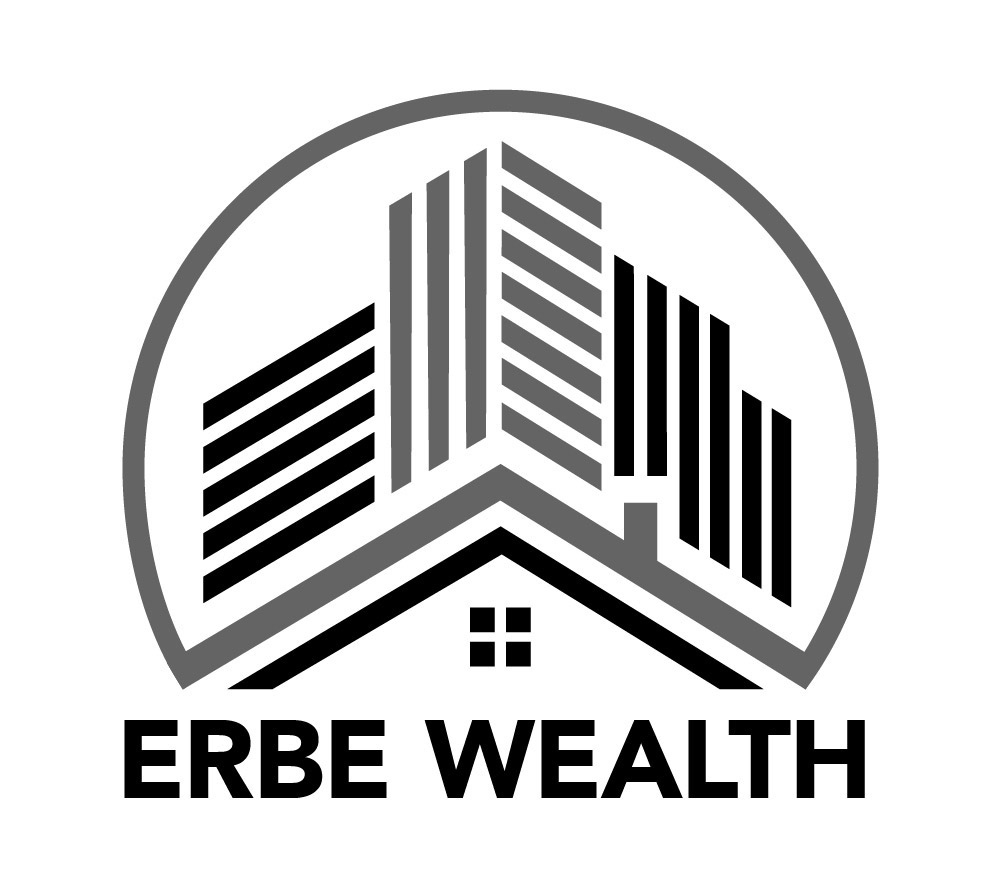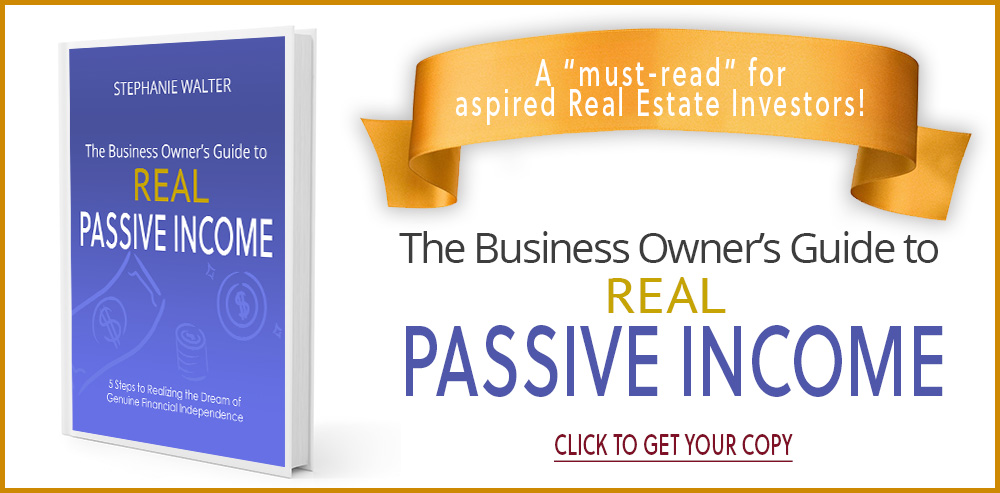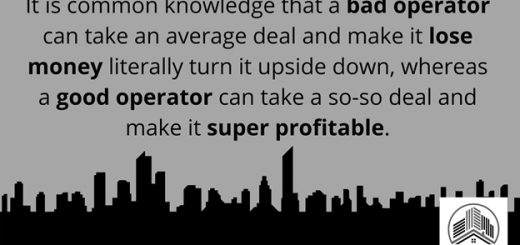Preferred Return in Real Estate Syndications
by Erbe Wealth · Published · Updated
Many people are interested in real estate investing, but they don’t have the time to be active, full-time landlords. Most people want monthly cash flow, tax advantages through depreciation, and the potential for financial freedom and early retirement. A big point of confusion is how passive investors are compensated in a real estate syndication.
One of the most important ways investors are compensated in a syndication is through what is known as a preferred return.
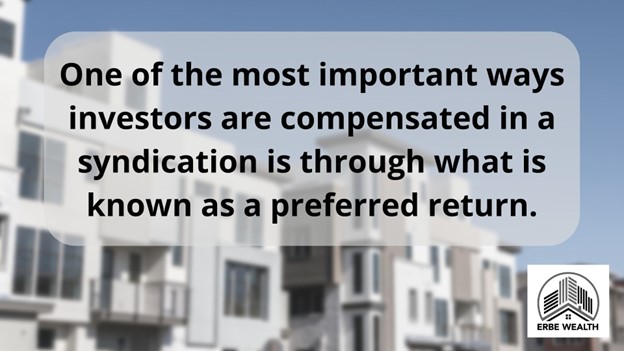
What is a Preferred Return?
A preferred return in private real estate syndication investing is the minimum return an investor must receive before the investment sponsor can earn a performance fee.
The preferred return is typically between 6% to 9% in real estate syndications, depending on the risk of the investment. You can think of this as an interest payment on your money as it accrues the same way, but it is not a guaranteed payment.
How does Preferred Return Work?
The preferred return is the order in which partners are repaid their equity investment and their share of the profits until a certain threshold has been achieved.
I can break this down with an example of how preferred return distribution would work in one of my deals. Let’s say the syndications operate in an agreement and set the preferred return hurdle at 7%. In this instance, assume that the property produces enough cash flow to distribute.
So, preferred return is simply a form of preferential treatment on who receives cash flows during the asset’s holding period or at the time of sale. If you have a preferred return, you are served first. You get the first share of the proceeds, protecting your downside risk in real life.
This means that even if the general partners couldn’t pay themselves, you will still receive your payment because you are legally in a higher priority position.
Why is Preferred Return Important?
Preferred return is a great way to reward investors who are first to the table or are willing to give a large amount of cash to the investment. It’s also a way to show your investors that you believe you will reach the percentage return you promised them and exceed it to pay other investors.
It is an important way to align the interests of the sponsors and the investors. The preferred return structure assures that the sponsor ensures that cash flow distributions will be paid to the investors before collecting anything. This shows the investors that you are confident that you will make a profit, which is a great way to attract good investors.
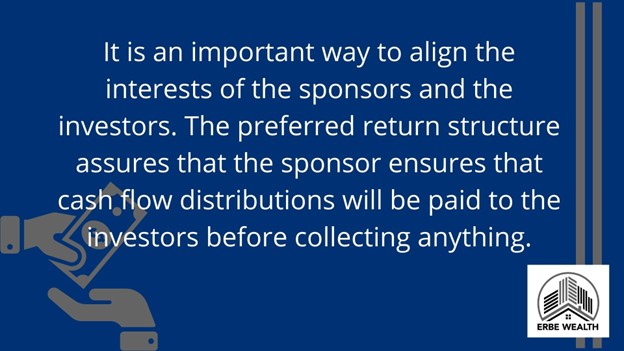
This helps to encourage the sponsors to not only fulfill but exceed the investment goals that have been set up. The sooner they start getting profits on their own, the more diligent they will be with the company’s business plan.
How are Preferred Returns Structured?
They’re often constructed with a hurdle rate, which must be surpassed in a capital distribution scenario.
For example, a preferred return of six percent means investors must achieve a 6% return on their investment before any other money flow occurs. Return hurdles might vary from 6% to 10%, but they generally fall between 6% and 8% percent before the deal is offered to investors for consideration. The return hurdle rate is always pre-determined.
The operating agreement outlines the specifics, and as an investor, it’s important that you receive and thoroughly review those documents. You should read this document and the investment offering very closely, especially if it is your first time investing or it is your first time working with a syndicated team. Reviewing the documents helps you understand how the preferred return works in your deal. Preferred returns can also be made up of a single payment or several payments over time. Our company pays our preferred returns every month.
Is the Preferred Return a Guaranteed Payment?
It is not a guaranteed payment, though no real estate investor is ever guaranteed.
One-way investors can safeguard their funds is to join a syndication team that offers a simple, preferred return structure.
This way, investors may rest assured that they will be repaid as soon as possible and before the sponsor makes any profits. Investors always need to read the Private Placement Memorandum included with any deal to know how the preferred return is structured. These legal documents will shed light on what kind of preferred return you can expect, the hurdle rates that must be surpassed, and the profit split.
What are Cumulative vs. Non-cumulative Preferred Returns?
When reviewing the Private Placement Memorandum, you want to make sure that you’re receiving a cumulative preferred return to protect your overall return. How does cumulative preferred return work? A cumulative preferred return allows you to add the missed return one year to roll over into the next year.
For example, if your preferred returns were 7% and you only received 6% one year, then your preferred return the following year would increase to 8%. In a cumulative preferred return, cash flow increases year over year from the asset. Then you would be made whole on the preferred return. The preferred would be caught up when you sell the asset if it still did not have the cash flow to make it up.
How does that differ from the non-cumulative preferred return? The difference is if you do not receive your preferred return in year one, then you lose it. The preferred return resets and does not carry forward. In the previous example, if the preferred return was 7%, but you only received 6% one year, you would get 6% and lose that 1% for the following year. It is not a preferred way to be treated as an investor in a syndicated offering.
Again, this is a critical point in reminding you to read your documents carefully to make sure you’re investing in projects with a cumulative preferred return.
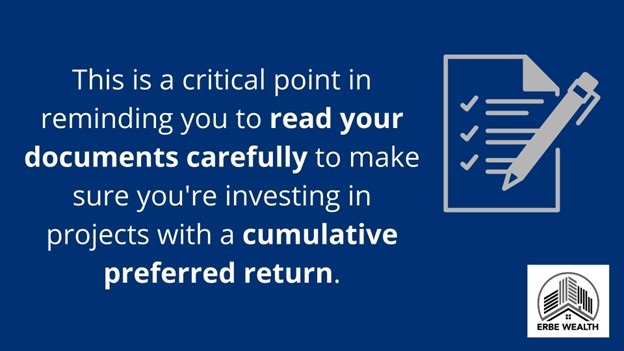
All of our investments at ERBE Wealth have this feature, so there’s nothing to worry about with us there.
Conclusion
The preferred return is a powerful tool for our group to show preferential treatment to our passive investors and to show that we are aligned in interest with our passive investors. Allowing preferred returns reduces the overall risk when investing in one of our offerings since you will receive the first proceeds of all cash flow.
Our offerings also provide cumulative preferred returns to ensure you receive the returns first, even if it has not been achieved yet. Finally, all of these details are important to us because we want to have our investors continue to invest with us again and again, this is the main reason why we go above and beyond to protect our investors’ return and their invested capital.
